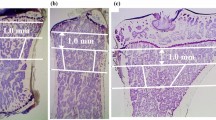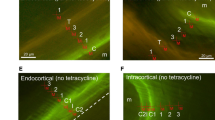Abstract
Serum procollagen I N-terminal propeptide (PINP) is a sensitive bone formation marker in humans. We have developed a nonradioactive immunoassay for rat PINP and studied PINP as a bone formation marker in the rat ovariectomy (OVX) model. Two OVX studies were performed with 3-month-old rats, both including measurement of PINP, C-terminal cross-linked telopeptide of type I collagen (CTX), and N-terminal mid-fragment of osteocalcin. A pilot 14-day study contained a sham-operated control group and an OVX group, and an extensive 8-week study contained a sham-operated control group and OVX groups receiving vehicle and 17β-estradiol (E2, 10 μg/kg/day s.c.). The bone markers were measured before the operation and at days 2, 4, 7, 10, and 14 in the pilot study and before the operations and at 2 and 8 weeks in the extensive study. Trabecular bone parameters were determined by peripheral quantitative computed tomography and histomorphometry from tibial metaphysis in the extensive study. The rat PINP immunoassay had the following characteristics: intra-assay coefficient of variation (CV) 2.8%, interassay CV 7.5%, dilution linearity 95%, and recovery 107%. PINP increased significantly during the first 2 weeks after OVX and returned to sham level at 8 weeks. E2 prevented the increase caused by OVX. Changes in PINP at 2 weeks correlated strongly with changes in CTX and osteocalcin at 2 weeks and with trabecular bone parameters at 8 weeks. As a conclusion, short-term changes in PINP predict long-term changes in trabecular bone parameters, suggesting that PINP is a reliable marker of bone formation in the rat OVX model.




Similar content being viewed by others
Abbreviations
- BMD:
-
bone mineral density
- CTX:
-
C-terminal cross-linked telopeptides of type I collagen
- OVX:
-
ovariectomy
- PINP:
-
serum procollagen I N-terminal propeptide
- pQCT:
-
peripheral quantitative computed tomography
References
Väänänen HK, Zhao H, Mulari M, Halleen JM (2000) The cell biology of osteoclast function. J Cell Sci 113:377–381
Girotra M, Rubin MR, Bilezikian JP (2006) Anabolic agents for osteoporosis: what is their likely place in therapy? Treat Endocrinol 5:347–358
Cremers S, Garnero P (2006) Biochemical markers of bone turnover in the clinical development of drugs for osteoporosis and metastatic bone disease: potential uses and pitfalls. Drugs 66:2031–2058
Sørensen MG, Henriksen K, Schaller S, Karsdal MA (2007) Biochemical markers in preclinical models of osteoporosis. Biomarkers 12:266–286
Garnero P, Sornay-Rendu E, Duboeuf F, Delmas PD (1999) Markers of bone turnover predict postmenopausal forearm bone loss over 4 years: the OFELY study. J Bone Miner Res 14:1614–1621
Gerdhem P, Ivaska KK, Alatalo SL, Halleen JM, Hellman J, Isaksson A, Pettersson K, Väänänen HK, Åkesson K, Obrant KJ (2004) Biochemical markers of bone metabolism and prediction of fracture in elderly women. J Bone Miner Res 19:386–393
Chen P, Satterwhite JH, Licata AA, Lewiecki EM, Sipos AA, Misurski DM, Wagman RB (2005) Early changes in biochemical markers of bone formation predict BMD response to teriparatide in postmenopausal women with osteoporosis. J Bone Miner Res 20:962–970
Finkelstein JS, Leder BZ, Burnett SA, Wyland JJ, Lee H, De la Paz AV, Gibson K, Neer RM (2006) Effects of teriparatide, alendronate, or both on bone turnover in osteoporotic men. J Clin Endocrinol Metab 91:2882–2887
Nenonen A, Cheng S, Ivaska KK, Alatalo SL, Lehtimäki T, Schmidt-Gayk H, Uusi-Rasi K, Heinonen A, Kannus P, Sievänen H, Vuori I, Väänänen HK, Halleen JM (2005) Serum TRACP 5b is a useful marker for monitoring alendronate treatment: comparison with other markers of bone turnover. J Bone Miner Res 20:1804–1812
Gurkan L, Ekeland A, Gautvik KM, Langeland N, Ronningen H, Solheim LF (1986) Bone changes after castration in rats. A model for osteoporosis. Acta Orthop Scand 57:67–70
Kalu DN (1991) The ovariectomized rat model of postmenopausal bone loss. Bone Miner 15:175–191
Melkko J, Kauppila S, Niemi S, Risteli L, Haukipuro K, Jukkola A, Risteli J (1996) Immunoassay for intact amino-terminal propeptide of human type I procollagen. Clin Chem 42:947–954
Hale LV, Galvin RJ, Risteli J, Ma YL, Harvey AK, Yang X, Cain RL, Zeng Q, Frolik CA, Sato M, Schmidt AL, Geiser AG (2007) PINP: a serum biomarker of bone formation in the rat. Bone 40:1103–1109
Parfitt AM, Drezner MK, Glorieux FH, Kanis JA, Malluche H, Meunier PJ, Ott SM, Recker RR (1987) Bone histomorphometry: standardization of nomenelature, symbols, and units. J Bone Miner Res 2:595–610
Ivaska KK, Hentunen TA, Vääräniemi J, Ylipahkala H, Pettersson K, Väänänen HK (2004) Release of intact and fragmented osteocalcin molecules from bone matrix during bone resorption in vitro. J Biol Chem 279:18361–18369
Ivaska KK, Käkönen SM, Gerdhem P, Obrant KJ, Pettersson K, Väänänen HK (2005) Urinary osteocalcin as a marker of bone metabolism. Clin Chem 51:618–628
Acknowledgments
The authors thank Ms. Maria Kapraali from Oulu University of Applied Sciences for her skillful technical assistance.
Author information
Authors and Affiliations
Corresponding author
Rights and permissions
About this article
Cite this article
Rissanen, J.P., Suominen, M.I., Peng, Z. et al. Short-Term Changes in Serum PINP Predict Long-Term Changes in Trabecular Bone in the Rat Ovariectomy Model. Calcif Tissue Int 82, 155–161 (2008). https://doi.org/10.1007/s00223-007-9101-6
Received:
Accepted:
Published:
Issue Date:
DOI: https://doi.org/10.1007/s00223-007-9101-6




